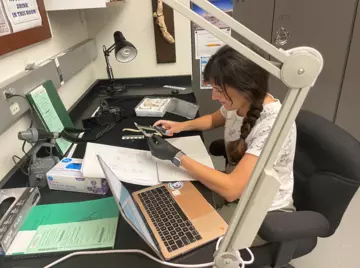
Palaeontology
Rewilding
Sturgeon
Institute of Zoology
Zoological Society of London
London
NW1 4RY
Uncovering the extinction stories of species using a combination of conservation palaeobiology tools – radiocarbon dating, stable isotopes, modelling, and ancient DNA – to directly inform conservation
The UK is experiencing a biodiversity crisis and species reintroductions and rewilding are increasingly being considered to restore biodiversity loss. The Dalmatian pelican (Pelecanus crispus) and European and Atlantic sturgeons (Acipenser sturio and A. oxyrinchus) are extinct native British wetland species that are now being considered as reintroduction candidates.
To determine whether reintroductions would be feasible and the ecological requirements of the species, Lucia compiles data from archives including subfossil bones and historical records. Lucia believes that a historical perspective is essential to understand how baselines have shifted and contextualize contemporary trends of population persistence and decline for these once widespread species. Specifically, this research utilises a combination of zooarchaeological, biomolecular (e.g. stable isotope analysis, radiocarbon dating, ancient DNA) and modelling approaches to understand the range collapse dynamics of the species. When and why did they disappear from the UK, and what was their role in British wetland ecosystems? Is there suitable habitat for them to return home in the near future?
Lucia collaborates with the UK Sturgeon Alliance and other conservation groups in the UK to provide a strong evidence base that will inform potential species reintroductions and rewilding to revitalize British wetland ecosystems.

2024-2028: PhD student, Scenario NERC DTP, Institute of Zoology and University of Reading
2024: Research Assistant, Middlebury College, Vermont (https://insectivora.org/)
2019-2023: BA Biology, Middlebury College, Vermont
Tobin, T. S., Roberts, E. M., Slotznick, S. P., Biasi, J. A., Clarke, J. A., O’Connor, P. M., Skinner, S. M., West, A. R., Snyderman, L. S., Kirschvink, J. L., & Lamanna, M. C. (2020). New evidence of a Campanian age for the Cretaceous fossil-bearing strata of Cape Marsh, Robertson Island, Antarctica. Cretaceous Research, 108, 104313. https://doi.org/10.1016/j.cretres.2019.104313
